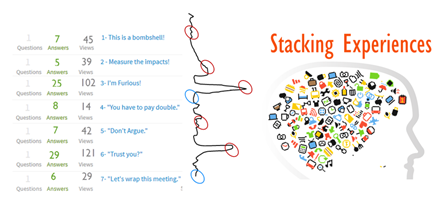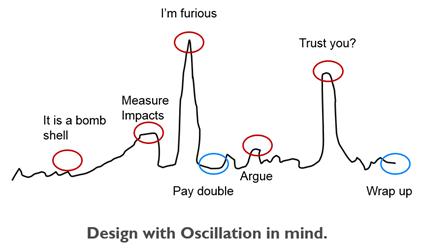Our belief: At Vignettes Learning we use stories in eLearning; however, we make them interactive. The emphasis is getting learners involved in the story and not just telling the learners the story.
Synthesis. In concept, using the experiences of learners to personalize eLearning design is ideal. At Vignettes Learning, we believe that ‘stacking experiences’ is one of the best ways to impart knowledge. However, methods and technology still need innovation to make this approach better or feasible.

Click here for the larger view.
I presented Learning Oscillation: How to Apply Advance Story-Based eLearning Design Techniques to Immerse Learners, a webinar on ‘stacking experiences’. The Oscillation method is presenting the emotional state of stories and allowing learners to bring in their experiences. Click to view the webinar handout.
The brain only processes 5% data and 95% remains unprocessed. The 5% are extraordinary and new events. The other 95% is just stored in the memory. Stories with emotional impacts are designed for the 5%. Experiences with embedded lessons are stacked in the brain especially those with the most significant emotional impact.
In our eLearning designs, we devise ways to create the same impact with emotion and personification. There is so much to be done in order to improve this process and even create new approaches to oscillate learning.
Sharing experiences is one of the best and reliable ways to learn. However, there is very little progress or a lack of method in the learning industry that enables learners and workers to share experiences effectively. Much of the sharing happens in social networks and collaboration tools. The exchanges of learning are mostly socially-driven or task-driven such as project activities and the like. To some extent they encourage sharing of experiences. The challenge we face, however,is how to weed out the “noise” in social communication and encourage “genuine” experience-sharing that adds value.
Stacking Experiences

The chart above indicates that learners respond to content because they find them meaningful. The content strikes a chord. It has a personalized impact. The items in red circles are examples of topics with personalization while those in blue circles have less personalization. Experiences are usually those topics encircled in red, at least for this illustration.
Experience is more important than data
Why is experience so much more important than data per se? Experience not only comes with factual data but also context of the value of the data. In Stacking Experiences, a software platform we are now testing, what we want to pursue is the systematic method of collecting experiences from peers and construct reliable learning and work knowledge around them. So I am constantly challenged about how to approach this – making experience a pivot of learning and knowledge.
Growth of data
The article of “The Data Made Me Do it” by Antonio Regalado convinced me that we have a long way to go in the commercial world in terms of personalizing data. According to writer Regalado, there is so much data on personal activities and behaviors, but the systems and platforms are not integrated.
Expounding further, Regalado writes:
“The holdup, says Wolfram, is that some of the most useful data isn’t being captured, at least not in a way that’s easily accessible. Part of the problem is technical, a lack of integration. But much data is warehoused by private companies like Facebook, Apple, and Fitbit, maker of a popular pedometer. Now, as the value of personal data becomes more apparent, fights are brewing. California legislators this year introduced a “Right to Know” bill that would require companies to reveal to individuals the “personal information” they store—in other words, a digital copy of every location trace and sighting of their IP address. The bill is a part of a social movement that is demanding privacy and accountability, but also a different economic arrangement between the people who supply the data and those who apply it. “
Furthermore, these movements may just one day help us realize what Stephen Wolfram observes to be the thrust of data personalization. Regalado adds:
“Wolfram is interested in predictive apps, but also in the insights that large data sets can have on personal behavior, something he calls “personal analytics.” Wolfram’s idea is that just as his search engine tries to organize all facts about the world, “what you have to do in personal analytics is try to accumulate the knowledge of a person’s life.”
What fascinates me in this discussion is the observation that data, personal or business, will continue to grow, faster than we are prepared to process. The personalization of this data is what will make it truly useful to people.
Although, we in the elearning and training industry might be too far out from the advances of the commercial and consumer world in data personalization, it is good to ponder and make some attempts to study and understand how we can apply the process to learning content and experiences – to enable us to perform better and accomplish our personal goals. I must mention here that there is a growing interest in the industry about the solution proposed by ExperienceAPI.com.
For your consideration
1. Think of ways to encourage learners to share experiences that solve problems, explore opportunities and enable better performance;
2. Reflect on where we can provide opportunities for learners to personalize the learning content, for example, always allowing learners to add their context and meaning to data and experiences of others;
Personalization is a dream of every learning designer. Let’s keep pushing and pursuing that goal.
Related Blog
Learning Facts and Foundational Knowledge with Stories
